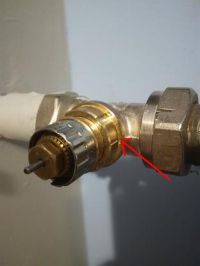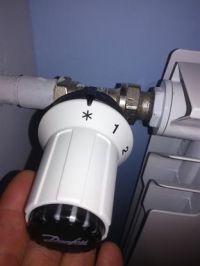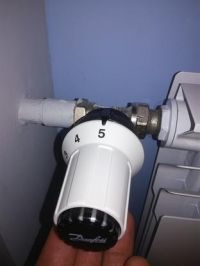FAQ
TL;DR: On Danfoss TRVs, “3 ≈ 22 °C” and that’s why rads feel cold on 1–3. “The head regulates room air, not the radiator.” [Elektroda, helmud7543, post #16864730]
Why it matters: This FAQ helps DIYers fix "cold-on-3" confusion, set the RA‑N preset ring, and avoid underheating or noise in apartment systems.
Quick Facts
- Reference mark: the engraved line on the valve body is the preset alignment point. [Elektroda, hajtaler, post #16865145]
- Head scale: * to 5 sets room temperature; 3 is about 22 °C comfort. [Elektroda, helmud7543, post #16864730]
- Presetting ring (1–7, N) limits flow for hydraulic balance; N = max flow. [Elektroda, hajtaler, post #16865051]
- First adjustment: reduce from 7 slightly (e.g., to 6) to retain capacity in deep frost. [Elektroda, Zbigniew Rusek, post #16864962]
- TRV heads control air temperature; supply temperature comes from the building heat source. [Elektroda, hajtaler, post #16865051]
Why are my Danfoss radiator heads cold on 1–3 and suddenly hot above 3?
Because the scale sets room air temperature, not radiator temperature. Around “3” targets about 22 °C, so the head throttles flow once the room reaches that. Below 3, it stays closed longer and the radiator feels cold. Above 3, it opens more and the radiator heats quickly until the room nears the higher setpoint. “Setting 3 in most heads corresponds to about 22 °C.” [Elektroda, helmud7543, post #16864730]
How do I preset a Danfoss RA‑N valve correctly? (3‑step)
- Remove the head; find the engraved line on the valve body (reference mark).
- Rotate the preset ring to your chosen value (e.g., 6) aligned to the mark.
- Refit the head and set comfort on the dial (usually 3–4).
This sets maximum flow for balance while the head still regulates room temperature automatically. [Danfoss RA‑N presetting guide]
Which mark on the valve do I align the preset ring to?
Use the engraved line on the valve body as the landmark for the initial setting. Align the chosen number on the ring with that line before reinstalling the head. [Elektroda, hajtaler, post #16865145]
Should I mount the head at OFF, cold, or max when reinstalling?
Set the ring using the valve’s reference line first. When refitting, the head’s dial position sets room comfort only; choose your normal setting (often between 3 and 4). The dial doesn’t affect the preset alignment itself. [Elektroda, hajtaler, post #16865145]
What do the symbols * to 5 mean on Danfoss heads?
They are room temperature targets. The snowflake (*) prevents freezing, 1–5 map to rising comfort levels, and around “3” is about 22 °C. This is why radiators often feel cool until the room drops below the chosen target. [Elektroda, helmud7543, post #16864730]
What is the presetting ring (1–7, N) and what does it change?
The ring limits maximum water flow through the radiator for hydraulic balance. Lower numbers reduce flow; higher numbers allow more. “The maximum flow is the N setting on the valve.” This affects how fast heat can be delivered, but the head still controls room temperature. [Elektroda, hajtaler, post #16865051]
What does the N position do?
N is the fully open preset, giving maximum flow. Use N only when a radiator is starved for water or during initial testing. After balancing, reduce to the smallest setting that still heats the room reliably. [Elektroda, hajtaler, post #16865051]
Where should I start—preset 2, 6, or 7?
Avoid jumping straight to very low presets. A practical starting point is to reduce from 7 slightly, for example to 6, so you keep capacity in severe weather. Fine‑tune from there based on comfort and system behavior. [Elektroda, Zbigniew Rusek, post #16864962]
Can a low preset cause underheating during wind and deep frost?
Yes. In a drafty room at −15 °C with wind on the window, a preset near 1 can leave the radiator barely warm even when the head calls for heat. With preset 7 it can run fully hot until the room recovers. [Elektroda, Zbigniew Rusek, post #16866235]
Why does my radiator heat “a lot” right after the thermostat clicks?
When room temperature falls below the setpoint, the TRV opens and allows more flow. If the preset is high, the radiator can get very hot quickly until the room nears the target, then it throttles again. That’s normal TRV action. [Elektroda, monkey22, post #16864542]
What indoor temperature should I target for comfort?
Typical comfort targets are around 22–23 °C. Set your head near “3” to start, then nudge up or down for your preference. Many users report comfort in this range without frequent manual changes. [Elektroda, monkey22, post #16864487]
What is a TRV (thermostatic radiator valve) in simple terms?
A TRV is a self‑acting valve with a head that senses room air and modulates water flow to hold the chosen room temperature. It does not set the radiator’s surface temperature directly. [Elektroda, hajtaler, post #16865051]
Does presetting one radiator affect others in my apartment?
Yes. Throttling one unit can shift flow to others. After changing a ring setting, check other rooms. You may need small adjustments across several radiators to keep the system quiet and balanced. [Elektroda, hajtaler, post #16871493]
Will reducing flow make pipes or valves hum?
It can. Noise risk rises with strong pumps and narrow pipes when you damp flow too much. If you hear humming after lowering the preset, back off one step and recheck balance across radiators. [Elektroda, hajtaler, post #16871493]
Can changing the preset actually change radiator temperature?
Yes, indirectly. Less flow increases the temperature drop across the radiator, so the inlet stays hot while the outlet cools more. This can make the panel feel cooler overall while still delivering required heat. [Elektroda, TomaszC., post #16865546]








